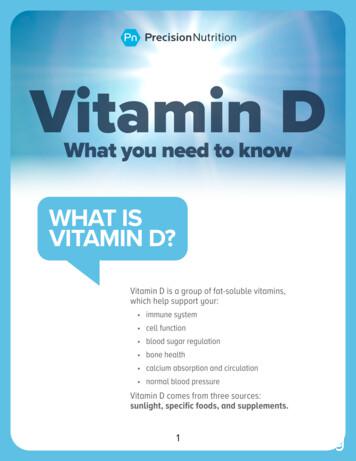Vitamin D Testing - Clinical Labs
Vitamin D TestingProviding you with insight in identifying& managing vitamin D deficiency
Vitamin D deficiency and health implicationsThe Australian Health Survey 2011–12 (ABS 2014b) foundhealth conditions such as cardiovascular disease, diabetes,that 23% of Australian adults had vitamin D levels underimmune system diseases, microbial and respiratorythe target of 50 nmol/L (vitamin D deficiency). This wasdiseases, cognitive impairment in older adults, mentallower in summer (14%) and higher in winter (36%).health and cancer.Vitamin D deficiency is of concern as it can lead to aThe below diagrams indicate the percentage of Australiansvariety of health conditions such as a loss of bone density,with a vitamin D deficiency in summer (diagram 1) versuswhich can contribute to osteoporosis and fractures.winter (diagram 2). As you can see, people residing inModerate to severe vitamin D deficiency in infants andthe southern states have an increased incidence of lowchildren can lead to rickets (soft bones). Low levels ofcirculating serum vitamin D levels, particularlyvitamin D have also been found in association with otherduring winter.Diagram 1 - Vitamin D deficiency in summer by state (2011-2012)Diagram 2 - Vitamin D deficiency in winter by state entage 10%10 to 20%20 to 30%30 to 40%40 to 50%14%Source: Australian Health Survey: Biomedical Results for Nutrients49%49%Percentage 10%10 to 20%20 to 30%30 to 40%40 to 50%43%Source: Australian Health Survey: Biomedical Results for NutrientsTarget vitamin D levelsThe international recommendations for adequate vitaminThis figure is based on the level below which parathyroidD levels vary, but based on a review of current literaturehormone concentrations begin to rise and the risk ofand recently published recommendations 1, 2 we suggestfractures increases.that adequate vitamin D status is a serum level equal to,or greater than, 50 nmol/L at the end of winter. This levelAs for all tests, Australian Clinical Labs’ pathologists andshould be 10-20 nmol/L higher at the end of summer toscientists will continue to evaluate current literature andallow for seasonal decrease.our target range may change as evidence emerges. 50 10-20 50adequate vitaminD levels in nmol/L atthe end of summeradequate vitamin Dlevels in nmol/L at theend of winterVitamin D Testing
Vitamin D levels throughout the yearThe below graph (graph 1) shows how the vitamin D levels in older Tasmanians vary throughout the year and where our targetvitamin D levels sit within this. The number of people that sit below the target levels can clearly be seen. 70 nmol/Lat the end ofsummer 50 nmol/Lat the end ofwinterGraph 1 - Relationship between mean daily solar exposure and serum 25(OH)D concentrations 5.Clinical recommendations Patients with:otreatment of osteoporosisWhen to testVitamin D testing should be ordered for patients at risk ofvitamin D deficiency.The best time to test vitamin D levels is at the end ofwinter, or in early spring, when patient vitamin D levelsare at their lowest.Who to test The housebound – including sick or disabled people Elderly in high care People with darker skin People who cover their skin due to religiousor cultural reasons People who regularly avoid the sun People who work indoorssigns, symptoms and/or plannedor osteomalaciaoincreased alkaline phosphatase withotherwise normal LFTsohyperparathyroidism, hypo- orhypercalcaemia or hypophosphataemiaomalabsorption (i.e. CF, IBD, coeliac, etc)omedications known to decrease vitaminD levels (i.e. anticonvulsants)oCRF and transplant recipientsFollow-up testingSerum 25-OHD should be retested no earlier than 3months following commencement of supplementationwith vitamin D or change in dose.Once a desirable target has been achieved, especially atthe end of winter, no further testing is required unless riskfactors change 2.
TreatmentTo ensure adequate levels of vitamin D are maintained throughout the year, the following sun exposure times (mins per day)are recommended for 1/3MED for moderate fair skin, at either 10am or 2pm daily 6.December - JanuaryJuly - August6-7 mins9-12 minsCairnsDecember - JanuaryJuly - August5-6 mins20-28 minsPerthDecember - JanuaryJuly - August6-7 mins5-19 minsBrisbaneDecember - January5-7 minsJuly - August25-38 minsDecember - JanuaryJuly - August6-8 mins26-28 minsSydneyAdelaideMelbourneDecember - JanuaryJuly - August6-8 mins32-52 minsDecember - JanuaryJuly - August7-9 mins40-47 minsHobartIf patients are unable, for a variety of reasons, to gain theSupplements should be vitamin D3 and adequate dietaryrequired amount of sun exposure for vitamin D production,calcium is also required. This should be at least 1g/daysupplementation may be required.and up to 1.3g/day in an older adult. Many will requiresupplementation to achieve this amount.A maintenance dose of up to 1000 IU/day may beadequate, however some individuals will require higherNote: Calcium supplements are best taken before sleep todoses. Severe vitamin D deficiency (serum level 20ensure maximum absorption and suppression of peak bonenmol/L) may require 3000-5000 IU/day for 6-12 weeks.turnover which usually occurs between approximately2am and 3am.clinicallabs.com.au
Vitamin D testing atClinical LabsWhat information is included inthe reportHow we test for vitamin D Vitamin D tests measure the total concentration of vitamin the concentration of total 25-hydroxyvitamin D(25-OHD) in a patient's serumprevious test results for comparison(if applicable)D, 25-hydroxyvitamin D (25-OHD), in the patient’s blood. and suggested cut points to define sufficient,deficient and severely deficient vitamin D levelsFurther testing A serum calcium assessment and parathyroidAustralian Clinical Labs’ utilise fully automated, state-of-hormone (PTH) will assist in placing the vitamin Dthe-art equipment to deliver accurate and reliable results.level within the context of overall calcium homeostasis If Osteoporosis is present, fasting blood crosslapsThe Siemens assay used by our labs for measuring vitamin(CTX) will provide a way of monitoring bone turnoverD is traceable to the NIST-Ghent University developedin response to therapyreference measurement procedure (RMP) based on An individual’s response to vitamin D supplementationisotope-dilution liquid chromatography-tandem masscan vary and should be checked after approximately 3spectrometry (ID-LC/MS/MS) 3,4.months of therapy
How to OrderRequest form instructionsOur Expert PathologistsDr Jonathan GraskoMBBCH, FRCPA, PDip (Med Tox)Medicare restrictions apply as to the reasons forbulk billing. Please refer to ‘Who to test’ on page 3for examples.Lab: Osborne ParkSpeciality: Chemical Pathology, ToxicologyPhone: 1300 367 674Email: Jonathan.Grasko@clinicallabs.com.auPatient instructionsN/A – there are no special patient requirements priorto testing.Dr Travis BrownBCom/BComp, BSc (Med), MBBS, FRCPASpecimen requirementsSerum collected using a Gold SSTll tube.Lab: Adelaide AirportAreas Of Interest: Information Technologyand Pathology InformaticsSpeciality: General PathologyPhone: (08) 8205 5604Email: Travis.Brown@clinicallabs.com.auDr David DeamMBBS, MAACB, FRCPALab: ClaytonAreas Of Interest: Endocrine FunctionTesting, Protein Abnormalities, LaboratoryAutomationSpeciality: Chemical PathologyPhone: (03) 9538 6777Email: David.Deam@clinicallabs.com.auDr Wessel Jenner1.Vitamin D and health in adults in Australia and New Zealand: a position statement.MJA 196(11), 18 June 2012.2.RCPA Position Statement: Use and Interpretation of Vitamin D testing. The RoyalCollege of Pathologists of Australasia, May 2013.3.Thienpont L, Stepman HCM, Vesper HW. Standardisation of measurements of25-Hydroxyvitamin D3 and D2. Scandinavian Journal of Clinical & LaboratoryInvestigation, 2012; 72 (Suppl 243): 41-49.4.Sempos CT, Vesper HW, Phinney KW, Thienpont LM, Coates PM. Vitamin DStandardisation Program (VDSP). Vitamin D status as an international issue:National surveys and the problem of standardisation. Scandinavian Journal ofClinical & Laboratory Investigation, 2012; 72 (Suppl 243): 32-40.5.Pittaway JK, Ahuja KDK, Beckett JM, Bird M-L, Robertson IK, et al. (2013)Make Vitamin D While the Sun Shines, Take Supplements When it Doesn’t: ALongitudinal, Observational Study of Older Adults in Tasmania, Australia. PLoSONE 8(3): e59063. doi:10.1371/journal.pone.0059063.6.Working Group of the Australian and New Zealand Bone and Mineral Society,Endocrine Society of Australia and Osteoporosis Australia. Vitamin D and adultbone health in Australia and New Zealand: a position statement. MJA 2005; 182:281–281300 134 1 1 1 VIC NSW SA NT1300 367 674 Western Australiaclinicallabs.com.auBSc, MBChB, FRCPALab: Bella VistaAreas Of Interest: Chemical Pathology,Endocrinology and ProteinsSpeciality: Biochemistry,Chemical PathologyPhone: (02) 8887 9999Email: Wessel.Jenner@clinicallabs.com.auAssoc. Prof.Mirette SaadMBBS (Hons), MD, MAACB, FRCPA, PhDLab: ClaytonAreas Of Interest: Molecular Genetics,Cancer Genetics, Antenatal Screening,NIPT, Endocrine, Fertility Testing andResearch, Medical TeachingSpeciality: Chemical PathologyPhone: (03) 9538 6777Email: BF-NAT-0010.7 08/19References:
Vitamin D deficiency is of concern as it can lead to a variety of health conditions such as a loss of bone density, which can contribute to osteoporosis and fractures. Moderate to severe vitamin D deficiency in infants and children can lead to rickets (soft bones). Low levels of vitamin D have also been found in association with other
Konsumsi asam folat, vitamin B12 dan vitamin C pada ibu hamil tergolong masih rendah, sehingga konsumsi sumber vitamin perlu ditingkatkan untuk mencegah masalah selama kehamilan, seperti anemia, prematur, dan kematian ibu dan anak. Kata kunci: asam folat, ibu hamil, vitamin B12, vitamin C *Korespondensi: Telp: 628129192259, Surel: hardinsyah2010@gmail.com J. Gizi Pangan, Volume 12, Nomor 1 .
Milk Thistle Red Clover Rhodiola St. John’s Wort Soy Bean Tomato Tribulus Terrestris Willow Vitamin B1 Vitamin B2 Vitamin B6 Vitamin B12 Vitamin C Vitamin D3 Vitamin E MISCELLANEOUS Alpha Lipoic Acid Beta Carotene Caffeine Choline Bitartrate Chond. Sulphate Bovine Chond. Sulphate Porcine Ch
Normal vitamin D 36% 9% 55% Vitamin D deficiency* Severe vitamin D deficiency** Normal vitamin D Camargo CA, Jr., Ingham T, Wickens K, et al. Vitamin D status of newborns in New Zealand. Br J Nutr 2010;104:1051 -7. Grant CC, Wall CR, Crengle S, Scragg R. Vitamin D deficiency in early childhood Public Health Nutr. 2009;12(10):1893-1901
25-OH Vitamin D levels* To determine vitamin D status * Only measure if patient is symptomatic and has risk factors for Vitamin D deficiency. Measurement, status and management (see Appendix 1 for flowchart) Vitamin D level Vitamin D status Health effect Management 30 nmol/L Defi
VITAMIN A This vitamin helps your body maintain healthy eyes and skin. VITAMIN C This vitamin helps the body heal cuts and wounds and maintain healthy gums. VITAMIN E This vitamin helps maintain healthy cells throughout your body. WATER Water makes up more than half of your body weight. Your
important.1 But the form of the vitamin D in it is. Look for supplements that contain: Vitamin D3, which is superior at optimizing and maintaining vitamin D levels long-term2 3 Or, if you prefer a plant-based option: Vitamin D2, which is derived from yeast or mushrooms For best absorption, take vitamin D with a meal, especially one that .
vitamin D stores that are further depleted by the lack of vitamin D in maternal breastmilk. These children are at high risk of childhood rickets. Key aims of Vitamin D supplementation To ensure: 1. Maternal Vitamin D levels are replete to avoid neonatal rickets. 2. Vitamin D deficiency is reversed in a timely manner. 3.
VITAMIN D3 VITAMIN D2 Ergosterol Not produced in humans 1/3 activity D3 7-dehydrocholesterol Produced by skin by UVB Fully active 16 VITAMIN D3 1,25(OH) 2VITAMIN D 3 VITAMIN D3 Biologically inactive Does not bind to VDR Nutritional substance 1,25(OH) 2 D 3 Steroid hormone Acts through Vitamin D Receptor (VDR) 17























